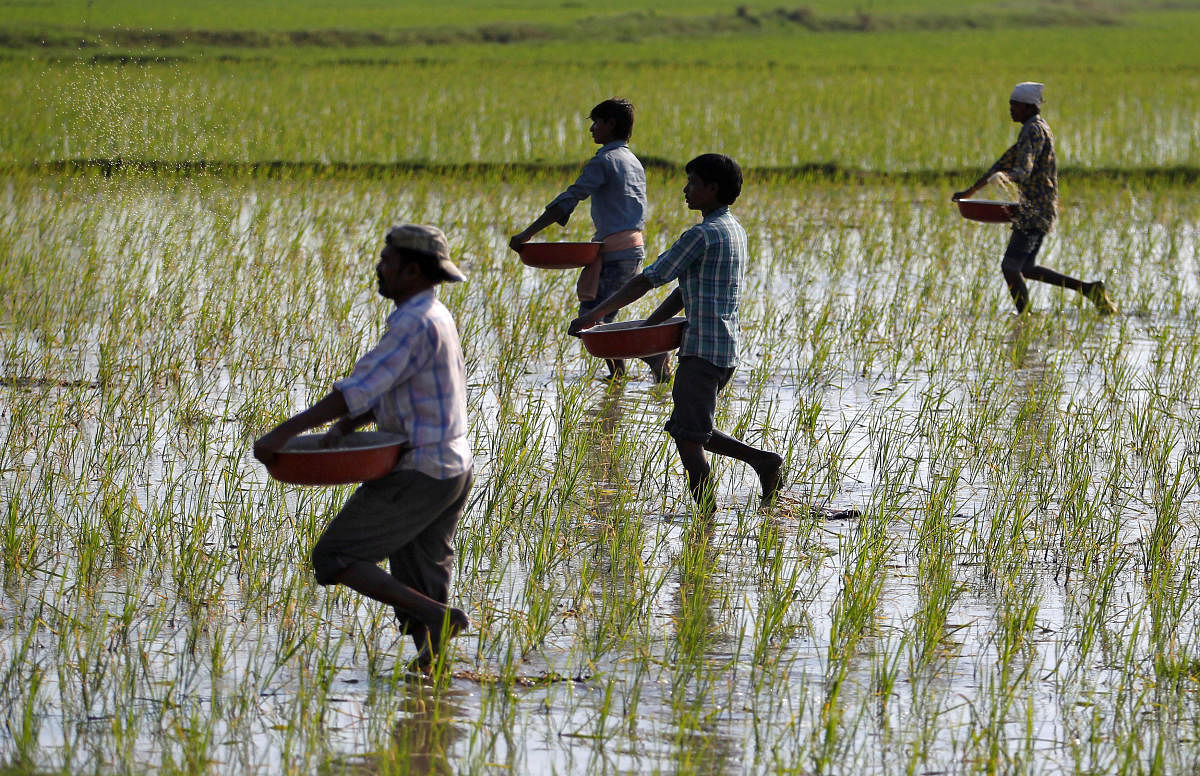
A panel under Niti Aayog member Ramesh Chand has recommended direct benefit transfer [DBT] of fertilizer subsidy with the stated objective to “dis-incentivize farmers from excessive use, ensure delivery to the end-user and reduce outgo on subsidy.” The intent is to launch the scheme in three-four months
DBT for fertilizer has been on the radar of policymakers for three decades. In July 1991, vowing to eliminate fertilizer subsidy in three years -- under pressure from the International Monetary Fund and World Bank -- the government had increased prices of all fertilizers by 40%. However, fearing political backlash, the hike was restricted to 30%, with a proviso that small and marginal farmers will be exempt from it. The Centre gave money [corresponding to 30%] to the states for direct distribution to the beneficiaries.
In reply to a question in Parliament, the then government had stated that a meager 3.5% of the small and marginal farmers received the benefit intended under the arrangement. The next year, the exemption for these farmers was withdrawn.
In August 1992, the government removed pricing and distribution controls on phosphate and potash fertilizers and abolished subsidy. However, in just five weeks, the subsidy was resurrected as an ad hoc concession. This was meant to be given directly to farmers, but it did not happen. The subsidy continued to go through manufacturers. Meanwhile, urea has remained under controls all through, with the subsidy going through manufacturers.
In 2000, the Expenditure Reforms Commission had recommended a roadmap beginning 2001-2 for removal of controls and subsidy on fertilizers. From 2005-6 onward, the government was expected to give subsidy directly to small and marginal farmers by distributing coupons encashable at the dealer shop. That recommendation gathered dust.
In Budget 2012-13, the UPA government had announced linking subsidy payment to manufacturers to the sale of fertilizers to farmers by retailers. Pilot projects in 10 districts spread over nine states were to be run; DBT to farmers was to be launched in these districts from April 2013, and nation-wide a year later. The plan was shelved.
In 2016-17, the Modi government launched the same pilot in 18 districts in 12 states. In April 2018, it was launched pan-India. Under the scheme, manufacturers receive 100% of the subsidy after fertilizer is delivered to the farmer and his Aadhaar number is captured at the dealer’s shop. Though termed DBT, in reality, it is not, as the subsidy continues to be routed through manufacturers.
So, for close to three decades, successive regimes talked about DBT of fertilizer subsidy, but none walked the talk. Even when this was implemented [in 1991-92], it was quickly withdrawn. In this backdrop, the recommendation of the Ramesh Chand committee is uninspiring. Its claim that DBT of subsidy to farmers can be launched in three-four months sounds like daydreaming. It took two years to affect a minor change in the manner of disbursing subsidy. How can a major transformation be brought about in a fraction of that time frame?
The government faces three major challenges. First, under the new pricing scheme [NPS] for urea, the subsidy -- being excess of production cost over controlled MRP -- varies from unit to unit. It gives protection to high cost units – a number of these being in the public sector, such as the Fertilizer Corporation of India, etc. Under DBT, this protection will go away. It will have to think of alternative mechanisms to ensure their continued viability sans NPS.
Second, currently, the government defers subsidy payments to manufacturers [for instance, in 2018-19, Rs 33,000 crore in dues were rolled over] to window-dress fiscal deficit. The manufacturers somehow continue operations by taking loans from banks. But, under DBT, payments to farmers cannot be delayed even for a day, which means the government will have to make an adequate budgetary provision. That means, window-dressing of accounts will no longer be possible. For an establishment used to this practice for long, the transition won’t be easy.
Third, under the extant dispensation of making fertilizers available at a low uniform price, all farmers, including the large or rich ones, have got used to enjoying the subsidy. That was more by default than by a conscious policy decision. Under DBT, this cannot continue. The government will have to manage the implications of withdrawing subsidy from the undeserving farmers.
Additionally, it will also need to brainstorm over the ‘criteria’ for determining subsidy under DBT. Unlike LPG, where a given number of cylinders eligible for subsidy in a year is considered uniformly for all households, here things are complex. Considering that fertilizer use varies depending on soil, crop, climate, farm size, etc., the quantity qualifying for subsidy on per hectare basis has to be different. Further, a view has to be taken whether subsidy can be capped at fertilizer use corresponding to, say, two hectares.
A third crucial determinant is the proportion in which different nutrients, namely, nitrogen [N], phosphate [P] and potash [K] besides secondary and micro-nutrients are used. Given that the cost of supplying these nutrients varies widely, the eligible subsidy can vary depending on the benchmark NPK ratio used for calculation.
Most importantly, the government will need to have data on all cultivating farmers. It will also have to zero-in on an ‘exclusion’ category, that is, those farmers who need not be given any subsidy.
Put simply, the government will need to cover a lot of ground before it can launch DBT. It won’t happen in the next three-four years even if the government were to take a political decision on it now, which itself is doubtful.
(The writer is a Delhi-based policy analyst)